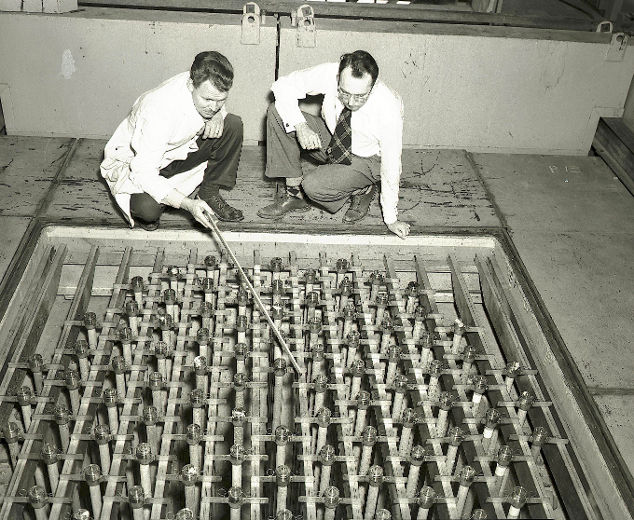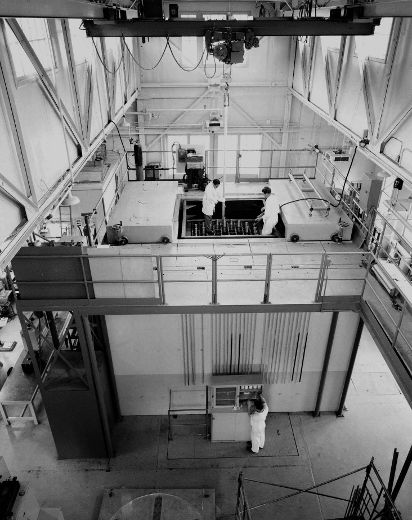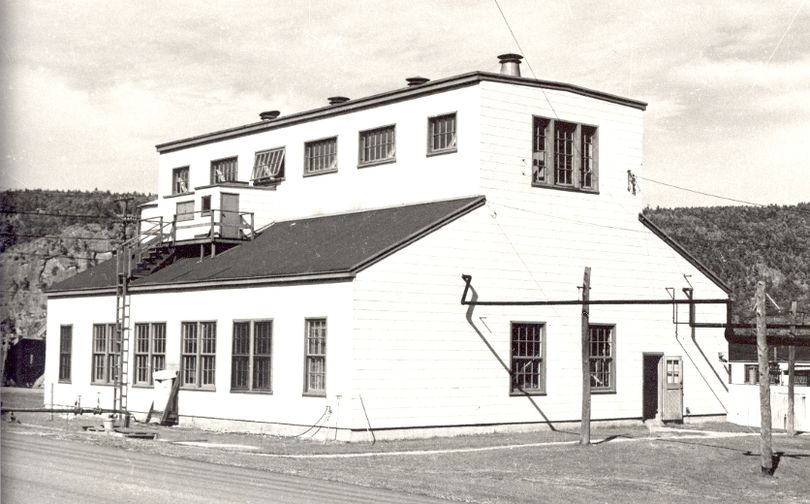|
Seventy Years in the Nuclear Age
by Jeremy Whitlock
published Sept. 16, 2015 in the North Renfrew Times, Sept. 19, 2015 in the Pembroke Daily Observer, and October 2015 in The Bulletin of the Canadian Nuclear Society.
Your comments are welcome.
Seventy years ago Canada became the second country on the planet to control nuclear fission - the nation barely seventy years old itself, with a well-earned reputation for punching above its weight class.
In September 1945 we were still getting used to the idea that the war was over, and the Atomic Age had begun. Two American bombs of unimagined power had ended the hostilities, followed shortly by a statement from the Canadian government that Canada had proudly played an "intimate" role in their development.
Post-war hubris aside, it was true that Canada had participated in the Anglo-American atomic bomb program, and had, by accident of geology and geography, come out of the war with the world's second largest nuclear infrastructure. The time would soon come to decide what to do with it, but for now, a month after the war's biggest secret was out, the focus was still very much on getting the job done.
Here, in a clearing on the wooded Ontario shoreline of the Ottawa River about two hours west of Ottawa, Canada would become the second nation to construct a working nuclear reactor. It was Sept. 5, almost a month to the day after the Hiroshima bombing.
For Lew Kowarski it was a moment of personal closure. Five years earlier the burly Russian-born scientist had escaped France aboard a collier on the eve of Nazi occupation, with almost the world's entire supply of "heavy water" - about 200 litres in 26 cans. Three months before that the precious scientific cargo had been spirited out of Norway, just ahead of the German invasion of that country. Once safely on English soil, Kowarski and fellow refugee scientist Hans von Halban continued their experiments with uranium and heavy water that they had pioneered in France.
By an extraordinary convergence of history, the most spectacular scientific discovery of the century, the splitting of the atom (or fission), had been discovered just prior to the outbreak of the largest global conflict in history, and the discovery was made in Germany. Furthermore, many of the practical advances in studying this new energy source were made in France, and now all of that was in German hands.
All, that is, except Kowarski, Halban, and their heavy water. It was known that uranium fission could generate a lot of heat, and that heavy water (a rare form of regular water) could help achieve this. Increasingly, the British government became convinced that they possessed the energy source for a new weapon of immense destructive power, and if that were true, then so did the Nazis. One outcome of this suspicion was a 1943 commando raid on the Norwegian hydro plant that generated the heavy water.

Scientists at work inside the ZEEP building at Chalk River, likely working on experiments with different fuel configurations and materials for reactors. [photo courtesy of Canadian Nuclear Laboratories]
Meanwhile, across the Atlantic in Ottawa, deep within the gothic laboratories of the National Research Council on Sussex Drive, Canadian scientist George Laurence closely followed Kowarski and Halban's work against the descending secrecy of WW II. By day, Laurence was responsible for teaching radiography to Canada's wartime aircraft industry, but in his spare time he worked towards building one of the world's first nuclear reactors.
Instead of heavy water, Laurence opted for carbon, a less efficient but cheaper and more available substitute. With 10 tonnes of the black, messy stuff (in the form of petroleum coke), and 450 kilograms of black uranium powder borrowed from Eldorado Gold Mines Ltd. in the Northwest Territories, Laurence conducted his experiments from 1940-42. In the summers he had help from Professor B.W. Sargent of Queen's University in Kingston, Ont.
The Holy Grail of this type of work was a self-sufficient nuclear reaction; that is, one in which uranium atoms continuously split each other in a chain reaction that requires no outside help. With purer materials and a full-time effort, Laurence might have been the first in the world to achieve this, but that honour went to Enrico Fermi on Dec. 2, 1942, in Chicago.

In the early days of work inside the ZEEP building at Chalk River, scientists were particularly interested in testing fuel configurations for the NRX being built next door. [photo courtesy of Canadian Nuclear Laboratories]
The Americans had awoken to the grim prospect of a German atomic bomb, and were now putting their fullest wartime machinery behind the task of getting there first. All agreed that if the Germans won this race, they'd win the war, regardless of their standing elsewhere in the conflict.
Britain and the United States, each with its own cadre of dispossessed European scientists, formed a top-secret nuclear alliance that in demographic, scope and intent could only have been conceivable during WW II. The world's most brilliant minds were locked in a macabre race to build the perfect weapon.
But there was more to it. Nuclear fission was an energy source of almost unlimited potential, both good and bad. In a Faustian twist, the scientists were also building the energy source of a postwar industrial boom, or so many thought.
Developing concerns over security and industrial patents strained the Anglo-American relationship, and when the British offered to move their group to America to escape the European theatre of war, they were flatly refused. This is where Canada came in. A British colony with an abundance of both water and uranium, plus skilled workers, open space, natural resources, energy and (not least in importance) proximity to the American effort, the choice was clear.
With a characteristic "Okay, let's go!" by Minister of Munitions and Supply, C.D. Howe, a decision was made to host the British project in the fall of 1942. It was a defining moment for Canada, shaping the future direction of its science and technology infrastructure and thrusting it directly onto the world stage.
The British group was assigned to the National Research Council, and was joined by a number of Canadians led by Laurence. Space was found in a building at the University of Montreal, in a suitably cosmopolitan city. The Montreal Laboratory, as it became known, had the task of designing a pilot heavy-water nuclear reactor for producing plutonium. Prior to the war, plutonium had only existed in trace amounts. Now it held a place alongside uranium as the miracle fuel of the future. Interestingly, plutonium could only be created in great quantities within a nuclear reactor, one example of which was now the Montreal lab's focus.
The task had military significance, but the greatest concentration of scientific minds in Canadian history set about its task with an eye on the other edge of the sword: NRC President C.J. Mackenzie later commented that the deciding factor in taking on the Montreal lab was the obvious long-term social and economic significance of atomic energy. Canada was getting in "on the ground floor of a great technological process for the first time" in its history. Mackenzie never expected the project to be finished in time to contribute to the war.

An exterior view of the building that housed the ZEEP reactor (Zero Energy Experimental Pile) at Chalk River, Ont. The building was eventually torn down to make room for the building of the Maple reactors. ZEEP continued to be used for basic research until 1970. It was decommissioned in 1973 and dismantled in 1997. In 1966 ZEEP was designated a historic site by Ontario, and commemorated with an historic plaque. Both this plaque and ZEEP itself are now on display at the Canada Science and Technology Museum in Ottawa. [photo courtesy of Canadian Nuclear Laboratories]
Indeed, it was July 1944 - a month after D-Day - when a site for the pilot plant was chosen about two hours west of Ottawa, seven kilometres north of the village of Chalk River on the shores of the Ottawa River. In utter secrecy a complete scientific lab was built from scratch, along with a town site-Deep River-for its workers a few kilometres to the west. Both sites were built by Defense Industries Ltd., with the familiar white and green colour scheme of Canadian military installations. Petawawa Works, as it was known during construction, looked like nothing more than an extension of nearby Canadian Forces Base Petawawa. This was, of course, the intention.
Chalk River Nuclear Laboratories was to host a 20-million-watt reactor called the NRX, for National Research X-Metal (X-Metal being the wartime code for uranium; later the name was changed to National Research Experimental, but it would always be known simply as NRX). First, however, a smaller test reactor needed to be built, and this assignment went to Kowarski.
Kowarski was one of the last of the British team to come to Canada, now lured by the chance to complete the quest he had begun five years before in France: construction of a heavy-water reactor. He named his reactor ZEEP, for Zero Energy Experimental Pile. The "zero energy" was due to the reactor producing barely any heat; "pile" was the jargon for reactors in those days, after Fermi built the first one in Chicago literally out of a pile of graphite (carbon) blocks.
The construction of ZEEP dragged on through the final days of the war, which ended in Europe in May 1945. Germany, it turned out, was never close to building an atomic bomb. In July the Americans had made enough plutonium of their own to secretly test the world's first atomic bomb in New Mexico. The world's second and third atomic bombs were dropped, less secretly, on Hiroshima and Nagasaki in August 1945, and that ended the hostilities with Japan.
Canada's first reactor, and the first one outside the U.S., started up a month later. Born out of military expediency within a larger American context, Canada's nuclear lab was suddenly a leftover wartime gift, fully staffed and ready to go.
On the books was the NRX reactor, already under construction. Never designed solely as a plutonium-producing reactor, the NRX came fully equipped for scientific experiments, including a number of "beam tubes" that permit streams of subatomic particles to leave the reactor and impinge on test materials.
When completed in 1947, NRX was the most powerful research reactor in the world. Canadian nuclear science defined the forefront of the art, and the little Canadian Pacific Rail station in Chalk River welcomed the world's greatest scientists and other VIPs to the heart of the Canadian Shield.
Significantly, Canada did not pursue the development of atomic weaponry, despite being one of the three countries on Earth at the close of WW II with the know-how to do so. Canadian research reactors at Chalk River did turn out a relatively small amount of plutonium for the American market until well into the Cold War, but the broader foresight of NRX's designers, and the scientific vision of the National Research Council, put Canada soundly on a path to peaceful nuclear research and development.
One thing the NRX could do better than any other reactor was make radioisotopes; that is, materials that give off radiation for industrial, medical, or scientific purposes. In 1949, Dr. Harold Johns of the University of Saskatchewan asked the NRC to make some radioactive cobalt for use in cancer therapy. The idea was novel at the time, and Johns led the field: the powerful energy from radioactive cobalt could be harnessed to kill cancerous cells, without unduly affecting the surrounding non-cancerous tissue. Elsewhere in Canada, Roy Errington of Eldorado Mining & Refining Ltd., made a similar request to the NRC at about the same time. The race for the "cobalt bomb" (as the media dubbed it) was on.
It was a slow race, since even the most powerful reactor in the world took a full two years to make sufficiently potent radioactive cobalt. The media was nevertheless intrigued. In 1951, the cobalt for both parties was extracted from NRX, but the Eldorado therapy unit was the first to be ready for clinical use. On Oct. 27, 1951, Dr. Ivan Smith's cancer clinic at Victoria Hospital in London, Ont., was the first in the world to treat a patient with radiation, using the Eldorado unit. The Saskatchewan team followed with its first treatment 12 days later (the Saskatchewan unit had an illustrious career, treating almost 7,000 patients over the next 21 years).
From those humble beginnings, Canada became a world leader in the production of medical radioisotopes and radiation therapy devices. In time, a fleet of massive electricity-generating reactors would follow, and eventually power half of Ontario and one-third of New Brunswick. The CANDU reactor, with a heavy water lineage directly to Lew Kowarski and ZEEP, today operates on four continents with a reputation for safety and efficiency.
This is a remarkable achievement for a largely empty country with a largely resource-based economy, and equally remarkable is its link to a single decision of wartime expediency and vision.
|
©2015 Jeremy Whitlock
|
Discussion welcome.
|
|



